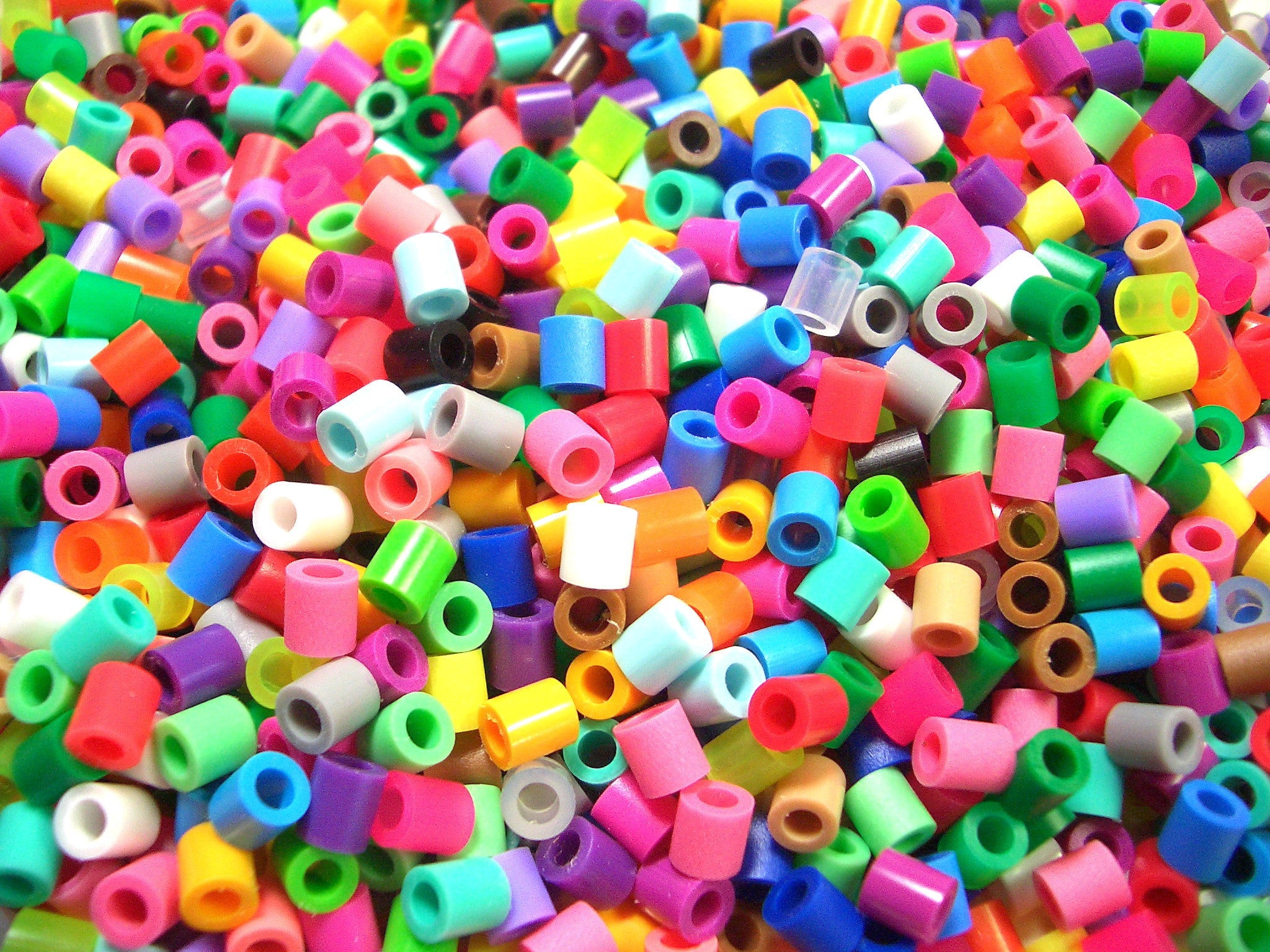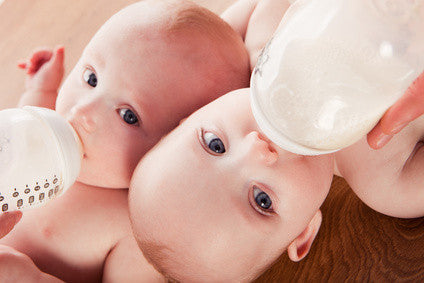Toxic Toy Story

By Jackie Hunt Christensen | EcoMall.com | Download
Ever wonder what your child's toys are made of? Chances are, if the toys aren't wood or metal, they're some kind of plastic. But what kind? Unlike most food containers or packaging, toys generally aren't marked with the triangle of "chasing arrows" and a "1," "2," or "4" in the middle that indicates the type of plastic used in its manufacture.
As a curious environmental activist and concerned parent of two, I decided to do some checking. I started with one of my girlhood icons, BarbieTM. Over a year ago, McDonald's restaurants were giving away miniature Barbies with their Happy Meals. A friend of mine was collecting them for her niece. I scanned Barbie's body for some sort of resin code (the ones that appear in the "chasing arrows" triangle) and found none. I called McDonald's to see what McBarbie (not her real name) was made of. They seemed perplexed that I should ask this question-why did I want to know? So I said my son had pulled off Barbie's leg and I wanted to know if she was recyclable. They assured me that yes, she was, but they didn't know what she was made of. So I called Mattel, the company that manufactures Barbie. Customer service representatives said that all Barbies are made of a plastic called polyvinyl chloride, or PVC.
Hearing this concerned me a great deal, and I began looking at my son Alex's plastic toys. Most of them were not labeled either, and the ones that were tended to be "2s" (high density polyethylene) or "5s" (polypropylene).
What's Wrong with PVC?
I'm concerned about PVC in my sons' toys for a couple of reasons: its potential for affecting their health, and its potential for harming the environment.
My son Bennett is almost 18 months old, and is working on his last four teeth. Everything goes into his mouth and is chewed with abandon. From my research, the risks to him come primarily from plasticizers called "phthalates" that are used to make the flexible PVC items like teethers. There are several phthalates that may be used in PVC, but the most common are di-ethylhexyl-phthalate (DEHP), di-isodecyl phthalate (DIDP), and di-isononyl-phthalate (DINP). Phthalates are not chemically bound to the PVC. Instead, they sit side by side with the polymer. This means that the phthalates can leach out of the PVC and into the surrounding environment-which may include my son's mouth. The Danish Department of Environmental Chemistry recently studied teething rings sold in Denmark and reported that "significant migration of certain phthalates was found...."
A large variety of health effects in wildlife and humans have been associated with phthalates. One of the most frightening, I think, is the possibility that phthalates may be chemicals that behave similarly to hormones in our bodies. Eight phthalates have been shown to be weakly estrogenic, which means they can cause responses in the body similar to those elicited by estrogen. As you probably know, estrogen is a hormone involved in reproduction and sexual development. Both men and women produce estrogen to regulate those important functions, but I don't want my son exposed to anything that might upset his body's own delicate balance.
Other effects of phthalates:
- DEHP has been shown to cause liver cancer in rats and is considered a potential human carcinogen.
- Rats exposed to dehp over long periods exhibited kidney damage similar to that seen in humans undergoing long-term kidney dialysis.
- High doses of DEHP and di-n-butyl-phthalate (DBP) have also been shown to affect reproduction and sperm production in rats.
- In the human body, dehp is converted to mono-2-ethylhexyl-phthalate (MEHP). MEHP has been found to cause cardiac and respiratory arrest in rats.
It must be noted that other than DEHP, many of the phthalates have not been well-evaluated for their possible health effects to humans. In my opinion, this means that my children are serving as guinea pigs. I would have hoped that our actions on thalidomide and diethylstilbestrol (DES) would have taught us to heed the warning sirens sounded by effects on animals.
The Consumer Product Safety Commission's (CPSC) Chronic Hazard Panel has met several times to discuss DEHP, but to date, the only action has been a voluntary reduction by domestic toy makers in its use for children's toys; the CPSC has not taken action on other phthalates or called for more studies on other phthalates, despite mounting evidence about their possible hormone-disrupting properties and other health effects. Personally, I would prefer that if toys must be made of plastic for some reason, a resin which does not require plasticizers should be used.
Alex, who is six, doesn't put his toys in his mouth much anymore. Ben, however, who doesn't yet understand the "laws" of toy ownership, does not discriminate between his own toys and Alex's. Were I to let him, Ben would just as soon chew on the PVC-stuffed Beanie Baby Alex got for his sixth birthday as his own polyester-filled terrycloth cow. That Beanie Baby, as well as other plastic toys in my house, has posed health as well as environmental dilemmas for me. Here's why:
The PVC Lifecycle
One of the reasons that PVC is bad for people and the environment is that two of the chlorine-based chemicals involved in pvc production, ethylene dichloride and vinyl chloride monomer, are hazardous in and of themselves. Ethylene dichloride is a possible human carcinogen and vinyl chloride monomer is a known human carcinogen. Production of those pvc "building blocks" can also produce dioxin, one of the most toxic substances known to humans. In the process of making vinyl chloride monomer into polyvinyl chloride for Barbies or thousands of other uses, more dioxin and other toxic by-products are also likely to be produced.
Dioxin is an unwanted by-product of a number of industrial processes, including incineration, chlorinated bleaching wood pulp cellulose, and the manufacture of PVC. It doesn't degrade easily and so builds up both in the environment and in our bodies, where it is stored in fat. Dioxin has been linked to a host of health effects in wildlife and humans, including various cancers, endometriosis, and problems with the body's hormone system, which is responsible for growth, sexual development, and reproduction.
PVC by itself is very brittle, so depending on the intended use, a variety of plasticizers and stabilizers may be added. Many of these compounds are toxic, too. Some common stabilizers used in PVC include lead and organotin compounds.
In 1996, lead was found to leach out of imported vinyl (PVC) mini-blinds, creating a lead hazard for small children. Lead affects the nervous and reproductive systems and in children, can cause permanent brain damage. We know lead is bad-that's why we don't let our kids eat paint. Why should we let them have toys that might contain lead? Organotins have been linked to birth defects in rats. All three of these heavy metals are suspected hormone-disrupting chemicals.
A 1997 report by Greenpeace USA sampled 131 toys and children's products for lead and cadmium. More than 20 percent were found to contain greater than 100 parts per million of lead. Most of the toys were purchased from chain stores like Toys R Us, Kmart, Wal-Mart, or Target and/or were major labels, like Disney or Barbie.
Lastly, because PVC contains so much chlorine (about 57 percent by volume), it can also produce dioxin when it is incinerated or accidentally burned. Burning PVC can also release the heavy metal stabilizers into the air and the environment. If I were to throw out that Beanie Baby in my household trash, it would be taken to our local garbage incinerator, where it could release any number of pollutants into the environment. So for now, we're stuck with it.
What About Recycling?
If Barbie or any other toy made of PVC happens to be labeled with a recycling code, it will be a "3." Recycling PVC is problematic, particularly because most PVC in commerce-including toys-is not labeled. PVC is a common contaminant in plastics collected for recycling, and its high chlorine levels may render polyethylene terephthalate (pet) or high-density polyethylene (hdpe) unrecycleable. When burned, pvc creates hydrochloric acid, which can "eat" the other resins. In fact, one PVC item can destroy up to 100,000 pet bottles.
PVC and Toys Around the World
Many European countries have already seen some action taken on PVC in toys. For example, some manufacturers voluntarily withdrew soft PVC toys from the market after the Danish Environmental Protection Agency (EPA) found that phthalates could leach from teething rings. One Swedish manufacturer, KF, voluntarily withdrew 75 products for testing. The International Council of Toy Industries of Europe has reportedly set up a working group on the health risks associated with PVC. The Danish EPA plans to use a system of taxes, labels, and public purchasing policies to eventually phase out phthalates. Sweden's government is considering a ban on phthalates in PVC toys for kids under age three and also promises that, "If the environmental impact of PVC is not reduced, PVC plastic will be banned."
As of this writing, the European Commission (EC) has just agreed to draw up a directive, to be prepared by EC Consumer Protection Commissioner Emma Bonino, that will address the use of phthalates in PVC products. Ms. Bonino had requested the EC to support a three-month ban on the sale of chewable soft pvc toys. Teething rings and other toys would have been banned because of health concerns-particularly liver damage-over the levels of DEHP and DINP found to leach out of the products. Yet our own US Commerce Department and Consumer Product Safety Commission may have played a role in the EC's decision not to invoke a ban which "might cause trade misunderstandings between the United States and the European Union."
As Swedish environment minister Anna Lindh has said, "The PVC industry has had a very long time to find substitutes for hazardous compounds but it evidently has not managed to do so.... It is the fault of the industry that PVC is no longer acceptable."
What's a Concerned Parent to Do?
Here are a few of the strategies I've employed to reduce my children's and the environment's risks from pvc toys. Next time you're shopping for a birthday or holiday gift, these are a few things to consider:
- Buy toys made of other materials, like wood, metal, or cloth. If you do buy plastic toys, look for ones made of non-chlorinated plastics, such as polyethylene ("2" or "4") or polypropylene ("5"). If it's not labeled, don't buy it.
- Contact your local outlets for chain stores like Toys R Us, Kmart, Wal-Mart, Target, etc., and tell them you want them to sell safe toys. Ask them to use their buying power as retailers to state a preference for (ideally) non-PVC toys, or at least, toys that are labeled as to which type of plastic is used, so that their customers can make informed buying decisions.
- Call Greenpeace at 1-800-326-0959 for more information on pvc and the campaign to get it out of toys.
- Contact Children's Environmental Coalition at 310-573-9608. CHEC is a grassroots organization that educates on the need to protect children from environmental toxins.
- Contact toy manufacturers and ask them to use non-chlorinated plastic resins when making toys.
- Ship discarded toys back to the manufacturers, or to the Vinyl Institute (a PVC-industry trade association). In my community, garbage gets burned in the local solid-waste incinerator, and I don't want my sons' discarded toys to emit toxic dioxins and lead into our local environment. Sending the toys back sends a message to the manufacturers that we want them to take responsibility for the pollution they create.
- Talk to other parents, teachers, daycare providers, etc. about PVC toy facts. Together, we can create "critical mass" to get safer toys made for our children.



